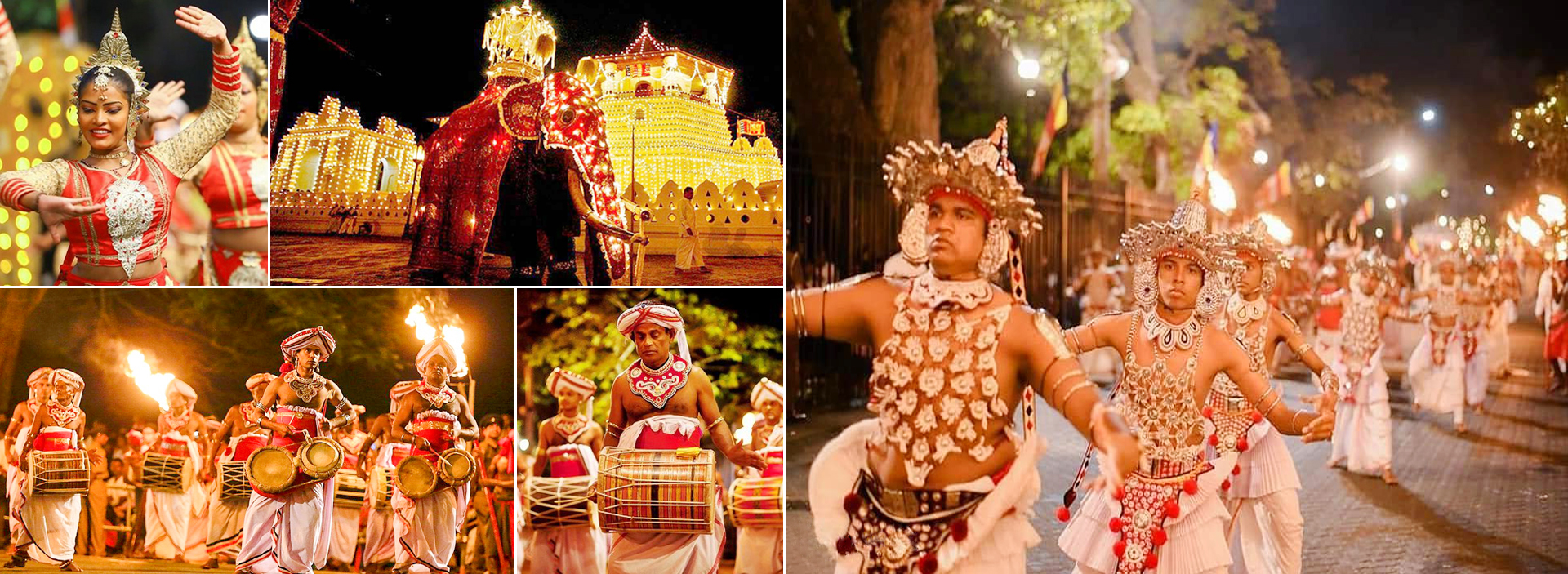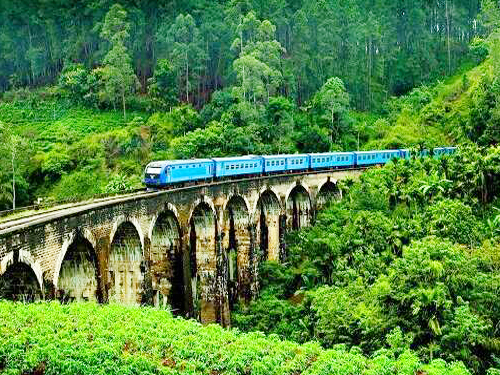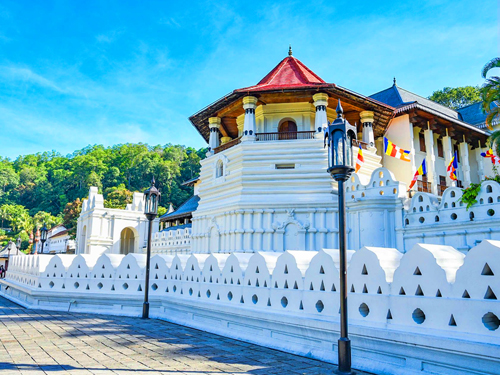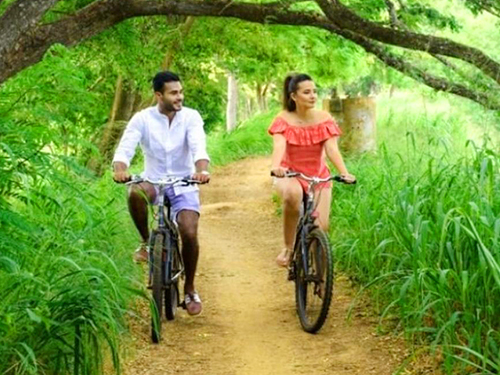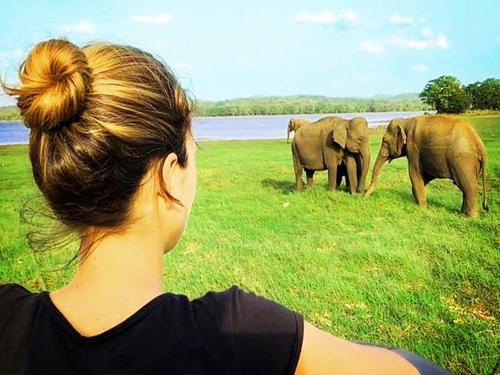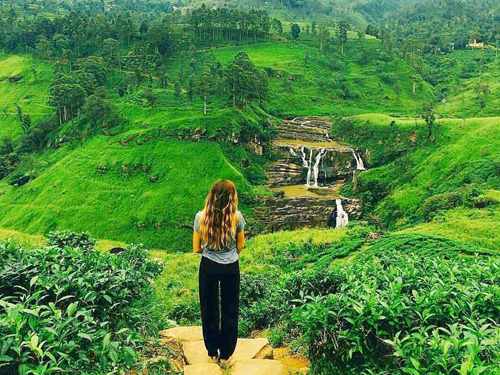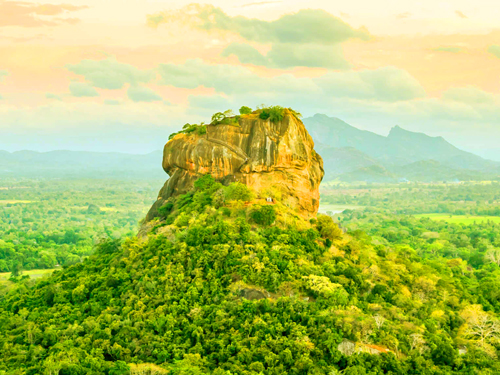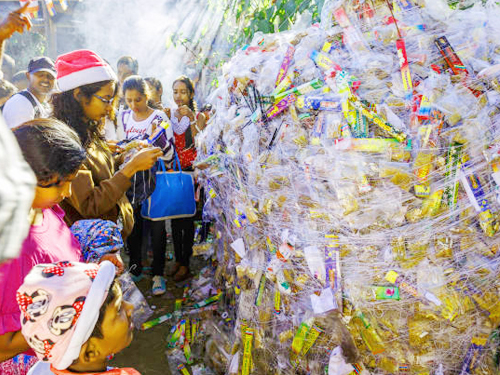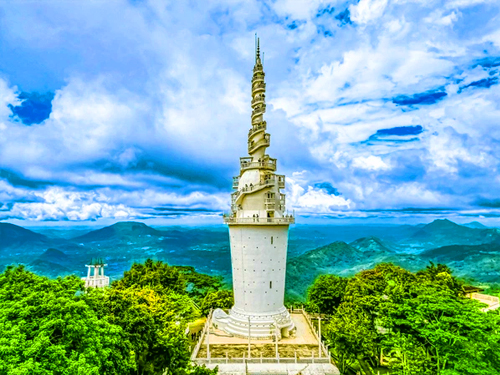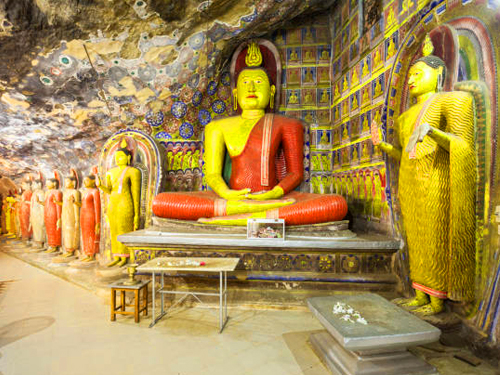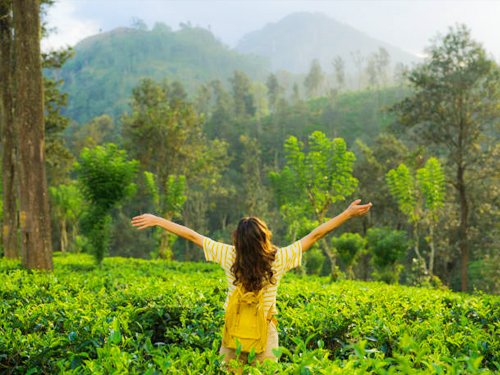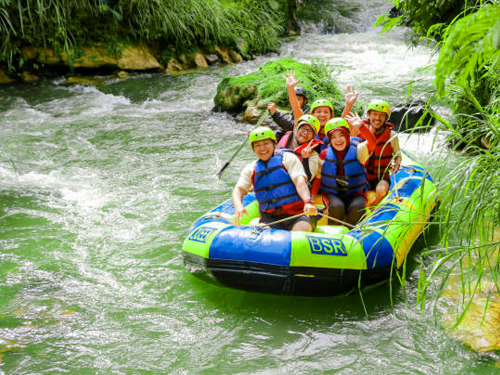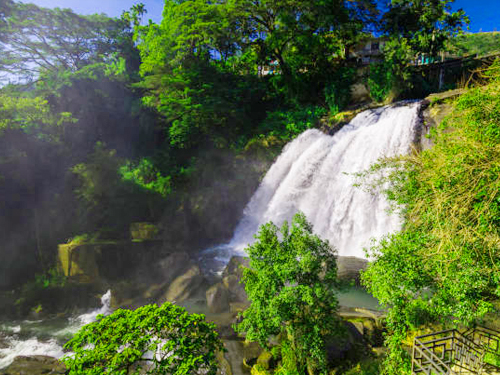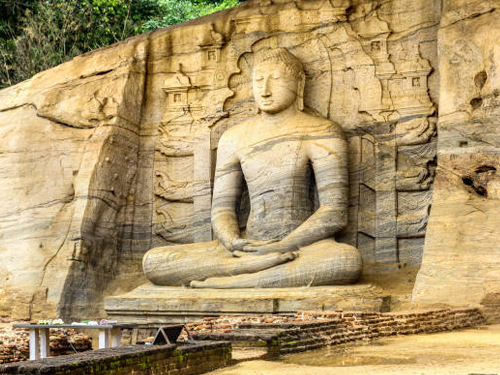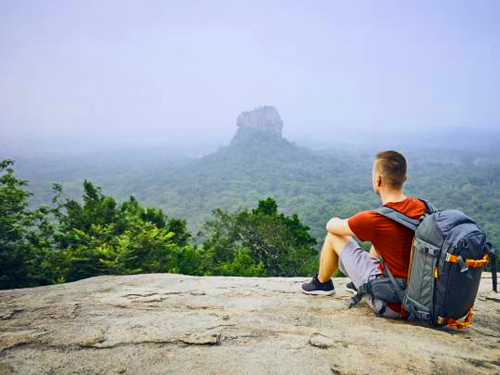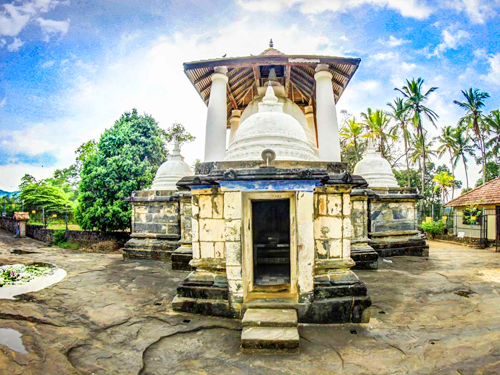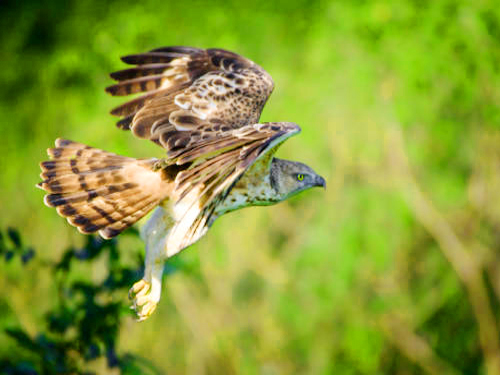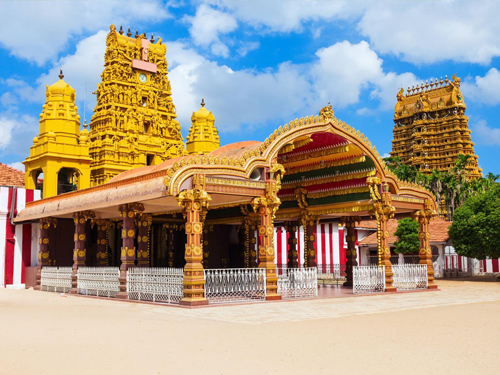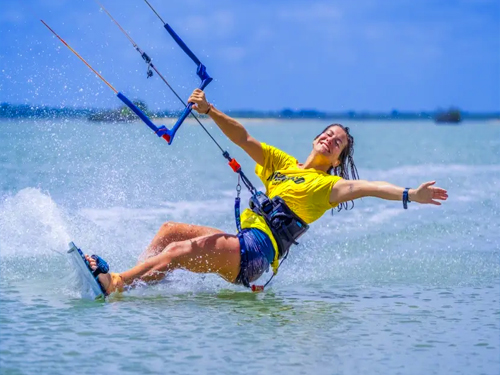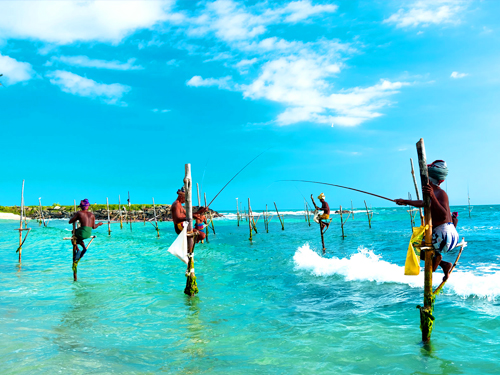Kandy in Sri Lanka
Kingdom of Kandy
SenaSammathaWickramabahu, 1473-1511, was the first king in the Kingdom of Kandy. He was a Kotte Royal Bloodline royal and ruled Kandy under the Kingdom of Kotte. This made Kandy the capital of the Kandyan kingdom. SenaSammathaWickramabahu's son Jayaweera Astana (1511-15551) followed him, and then Karaliyaddebandara (1551-1581), who was succeeded his daughter Dona Catherina (1581-1581). Rajasinha II succeeded Dona Catherina. Rajasinha, however, preferred to control the hill country from the Kingdom Sitawaka, on the west side of the island. After a turbulent period for power, KonappuBandara rose to the throne to become Vimaladharmasuriya II. He converted to Buddhism and brought the tooth relics of the Buddha to Kandy, from Delgamuwa.
Kandy was established as the capital of the last independent kingdom on the island in 1592, after the coast regions were conquered and occupied by the Portuguese. Many invasions by Portugal were defeated, including the Campaign of Danture. The Sinhalese-Portuguese War ended the Dutch attempts to take over the kingdom.
Although attacks were occasionally launched, the kingdom was able to tolerate a Dutch presence along the coast of Sri Lanka. King KirtiRajasinha launched the most ambitious offensive in 1761. He overran the majority of the coast and left only Negombo, which was heavily fortified, intact. Kirti Sri Rajasinha retreated into the interior of the island after a Dutch force attacked the island. The Dutch returned to the jungles in 1763, but were continually harassed by heat, disease, lack of provisions and Kandyan sharpshooters. They hid in the jungle, inflicting heavy losses to the Dutch.
In January 1765, the Dutch sent a more adapted force. They replaced their troops' bayonets by machetes and used more practical uniforms and tactics that were better suited for jungle warfare. After capturing the capital, the Dutch were unable to capture it. The Kandyans fled to the jungles again, refusing to fight in open combat. The Dutch were defeated again by constant attrition. In 1766, a peace treaty was made. The Dutch held the coast areas until 1796 when Great Britain took control (while France was still under French control). This was due to the Kew letters that were sent during the Napoleonic Wars. The treaty of Amiens, 1802 formalized British control over these areas. In 1802, the British formally claimed these areas through the treaty of Amiens. However, they were defeated in the First Kandyan War.
Kandy was home to the relics of the tooth of Buddha. This symbolises a 4th century tradition that was linked to the Sinhalese monarchy. The protector of this relic was also the ruler of Kandy. The Royal Palace and the Temple of the Tooth were thus placed close together.The Nayaks were the last ruling dynasty in Kandy. Kandy was independent until the 19th century, when the Kandyan Convention was signed by the British and Kandyan Chiefs.
The British launched an invasion against the city in the Second Kandyan War. They met no resistance on the 10th of February 1815. With the signing of the Kandyan Convention at the Sri DaladaMaligawa in 1815, Sri Lanka was finally able to fall into the hands a foreign power for the first time. VikramaRajasinha, the king of Kandy, was of South Indian descent and faced strong opposition from Sinhalese chieftains who sought to lower his power. The Sinhalese chieftains organized a successful coup in which they accepted the British crown and made him their new king. This brought an end to over 2500 years worth of Sinhalese monarchs. Rajasinha, the Kandyan monarchs' line, was also ended. The British Empire had taken over the sovereignty of the island by 2 March 1815. The Kandyan Convention, also known as the British-Kandyan Agreement was signed by the Radalas (Kandyan noblemen). The treaty was signed not by the deposed King, but by members his court and other dignitaries from the Kandyan kingdom. This treaty made Kandy recognize George III as its King, and it became a British protectorate. Sri VikramaRajasinha, the last king of the kingdom, was captured by the British and taken to Vellore Fort in south India with all claimants for the throne. Some family members were exiled to Tanjore, now known as Thanjavur in Tamil Nadu. Their former home is still called "Kandy Raja Aranmanai", in the eastern part of Thanjavur, on Old MariammanKoil Road.
Kandy Colonial Era
The history of Kandy and the townscape saw a dramatic change during the British period in Sri Lanka. This was especially true after the Uva Rebellion. Sir Lowry is known for his Gazetteer recording "The story English rule in Kandyan during the rebellion in 1818 cannot be told without shame...Hardly any member of the leading families survived...Those whom sword and gun had spared, cholera, small pox and privations had been slain in their hundreds... Others became ignorant and apathetic. Any subsequent government development efforts over many years were just attempts that were abandoned.
Gongalegodabanda and PuranAppu led the Matale Rebellion in 1848. The country and city had been under British control for 32 years. During that time, the British expropriated the common land and reduced the peasantry to extreme poverty. Kandyan villager were forced to give up their traditional lifestyle and work in wage-work under the terrible conditions on new estates and plantations. The colonials tried to pressure the Kandyans, but they refused. The British had to import hundreds of thousands from southern India of Tamil coolies.
Gongalegoda Banda was crowned as king and PuranApu as prime minister. Their main goal was to capture Kandy from the British. The Matale Rebellion was a revolt by peasants in the hands the Common people. This rebellion marked the first step towards a transition from anti-colonial rebellion to modern independence struggles. For the first time, the Kandyan provinces were handed over to ordinary citizens or non-aristocrats.
Contemporary Kandy
It is the capital of the Central Province in modern Sri Lanka and the second-largest municipality on the island. Because of its geographic location, it is a major transport hub in the island. Kandy, which is the gateway to Sri Lanka's Central Highlands, can be reached via major motorways that run through the entire island. The railway line runs from Colombo (the seaport on the west coast) via Kandy to Badulla in Central Highlands. Two of Sri Lanka's most beautiful roads are Kandy - NuwaraEliya and Colombo - Kandy - NuwaraEliya. While Colombo - Kandy-Kandy passes through rubber, tea plantations, and rice paddies while Kandy - NuwaraEliya cuts through paddy fields, seamless tea plantations, and bamboo plantations. Both roads wind their way through the hills, circling around the rings of hills. At the moment, feasibility studies are underway for a new highway linking Colombo with Kandy via Kadawata or Katugastota.
Kandy's Geography
Kandy is found in the densely forested mountainous interior of the island. It is situated between several mountain ranges, including the Knuckles Mountain Range and the Hanthana Mountain Range. This gives it an elevation of 500m (1,600 feet) above sea level. It is located south of UdawattaKele Sanctuary and adjacent to artificial Kandy lake. UdawatteKele has begun to reduce its area.
Climate in Kandy
It is classified as tropical rainforest in the Koppen-Geiger climate system. Kandy is located in the middle of the island at a high altitude. This means that the city experiences cooler and wetter temperatures than the rest of the country's tropical climate, particularly the coast. Because of its higher elevation, NuwaraEliya has a cooler climate. Kandy's climate, however, is tropical. The average temperatures all year are over 18 degrees Celsius. From January through April, the city experiences a dry period. The region's monsoon season is from May through July, October through December and October through December. During this period the weather can be unpredictable and rough. The intermonsoonal season is from March to the middle May. It is characterized by light rain and high humidity. The humidity ranges from 70% to 79%.
Demographics in Kandy
Kandy is a Sinhalese-majority city. However, there are large communities that belong to other ethnicities such as Moors or Tamils. The city is still a major religious center for the Sinhalese, and a popular place of pilgrimage by Buddhists, particularly those who belong to Theravada schools. A diocese of the Catholic Church is located in the city.
World UNESCO Sacred Cities of Kandy World UNESCO Sacred Cities of Kandy
This holy Buddhist site is also known as Senkadagalapura. It was once the capital of Sinhala kings, whose patronage allowed the Dinahala culture flourish for more than 2500 years before the British took over Sri Lanka in 1815. It is also home to the Temple of the Tooth Relic, the sacred tooth of the Buddha. This famous pilgrimage site is also located here.
Kandy City's main attractions
The Temple of the Sacred Tooth Relic, also known as Sri DaladaMaligawa is a Buddhist temple located in Kandy, Sri Lanka. It is located within the royal palace complex in Kandy's former Kingdom. This building houses the relic of Buddha's tooth. The relic is believed to have been a key part of local politics since ancient times. It is believed that the person who holds it holds the power to govern the country. Sinhalese kings held the relic in the past. Due to the temple and the associated relic, the temple of the tooth has been designated a World Heritage Site.
The two chapters of Asgiri and Malwathu have their Bhikkhus worship daily in the inner chambers of the temple. Three times daily, rituals are held: in the morning, noon, and evening. Wednesdays are devoted to symbolic bathing the relic in a herbal preparation of scented water and fragrant plants called NanumuraMangallaya. This holy water is believed have healing properties and is given to all who are present.
According to legend, after the Mahaparinirvana Buddha Gautama Buddha, the tooth relic was kept in Kalinga, and was smuggled to Kalinga by Princess Hemamali, her husband, Prince Dantha, on instructions from her father King Guhasiva. Hemmamali kept the relic in the hair of her companion on the journey to the island. The relic of the tooth was handed to them by Sirimeghavanna, who ruled Lankapattana in the reign of Anuradhapura (301-328). It was enshrined in MeghagiriVihara, which is now Isurumuniya in Anuradhapura. The monarch was responsible for the safekeeping of the relic from that time. Therefore, over the years the custodianship became synonymous with the right to control the island. The tooth relic temples were built close to the royal residences of reigning monarchs during the Anuradhapura Kingdom and Kingdom of Polonnaruwa periods. The Kingdom of Gampola era saw the relic housed at NiyamgampayaVihara. According to the messenger poems Hamsa, Gira and Selalihini, the temple of the tooth relic was located within Sri JayawardenepuraKotte at the time that the Kingdom of Kotte was founded there.
The relic was moved during the reign of Dharmapala, Kotte. It was then hidden in DelgamuwaVihara in Ratnapura in a grinder stone. King Vimaladharmasuriya I constructed a two-storey structure to store the tooth relic. The building is now gone. It was taken to MedaMahanuwara, Dumbara, in 1603 by the Portuguese kingdom that invaded Kandy. It was found in Rajasinha II's time. Reports say he either rebuilt or restored the original temple. ViraNarendra Sinha built the present-day temple to the tooth. The octagonal Paththirippuwa (and moat) were built during the reign Sri VikramaRajasinha. DevendraMoolacharya, the royal architect, is credited for building the Paththirippuwa. It was originally used for recreational purposes by the King, but later it was given to the tooth relic. Today it houses the temple's library.
The water waves wall is the brick wall that runs alongside the Bogambara Lake and the moat. This wall has holes that can be used to light coconut oil lamps. Mahawahalkada is the name of the main entrance gate that lies above this moat. The Sandakadapahana, a moonstone carved in Kandyan style, can be found at the foot of Mahawahalkada's steps. Mahawahalkada was completely destroyed by a 1998 bomb blast. It was rebuilt with SandakadaPahana and other stone carvings. On either side of the entrance, you will see stone carvings depicting elephants. The staircase is topped by a MakaraTorana, and two guardian rocks. The main shrine is located in front of TheHewisi drummers’ chamber. The main shrine's two levels are called "Pallemaalaya" (lower) and "Udumaalaya" (upper) respectively. Ivory carvings are used to decorate the doors of WedaHitanaMakligawa. The "Handunkunama" is the actual room in which the tooth relic is kept.
Assoc. buildings and structures
Royal Palace
To the north of the temple is the royal palace. [10] John Pybus was an embassy official in 1762 and gives a detailed description about the royal palace. [11] Vikramabahu I of Gampola (r.1356-1374), and SenaSammathaWickramabahu (r.1469-1511), built royal palaces at this location. The palace was decorated by Vimaladharmasuriya, I of Kandy. PhilippusBaldaeus, a Dutch orientalist, visited the palace in 1656 with General Gerard PieterszHulft. Since the Polonnaruwa era, the royal residence was called "MahaWasala" by Sinhalese. The royal palace is also known by the name "Maligawa", (Palace). Three Wahalkadas were present, as well as a wall 8 feet (8.4 m) tall that served as the main entrances. According to legend, the section facing NathaDevale is the oldest. It was used by Sir John D'Oyly 1st Baronet of Kandy during the British period. It has been used as an official residence by the D'Oyly family since its inception. It is now an archaeological museum. The palace also has UlpenGe and Queens Palace.
Auditorium of Temple of Tooth Relic
The Kandyan monarchs held their court in the magulmaduwa, or audience hall. It was built during the reign Sri VikramaRajasinha. The wood carvings on the wooden pillars that support the wooden roof is an example of Kandyan wood carving. It was built by Sri RajadhiRajasinha, Kandy in 1783. In 1872, Albert Edward, Prince-of- Wales, arrived in the hall. The hall was then renovated. The original dimensions of the hall were 58 by 35.6 feet (17.7m x 10.9mm); it was lengthened by renovation by 31.6 feet (9.6m). [14] There are other buildings near the halls that were thought to have been demolished under British rule. This was the place where the Kandyan Convention was drafted. It was also where the convention was read aloud to the public. The conference about the convention took place on the 2nd March 1815. Later, it was used for the construction of Kandy Kachcheri as well as Kandy Supreme Court. It is now used for state ceremonies, and it is conserved by the department of archaeology.
Mahamaluwa
Mahamaluwa is a public visitor who came to the annual EsalaPerahera. It now houses a MaddumaBandara statue. Another attraction is the memorial that contains Keppetipola's skull. Here are also the statues of Princess Hemamali, and Prince Dantha.
Kandy Lake
Kandy Lake, also known as KiriMuhuda, or the Sea of Milk is an artificial lake located in the heart of Kandy (Sri Lanka), built by King Sri WickramaRajasinghe in 1807. It is next to the Temple of the Tooth. It has been reduced in size over the years. It is protected from the elements and fishing is prohibited.
Peradeniya Royal Botanical Garden
The Royal Botanic Gardens, Peradeniya can be found about 5.5km west of Kandy in Central Province of Sri Lanka. The garden was visited by over 1.2 million locals in 2016 and over 400,000 tourists from abroad. It is located near the Mahaweli River, Sri Lanka's longest river. It is well-known for its orchid collection. It contains more than 4000 species, including medicinal and tropical plants. It is also home to the "National Herbarium of Sri Lanka". It covers 147 acres (0.59km2) and is located at 460m above sea level. The garden receives 200 days of annual rainfall. It is managed by the Division of National Botanic Gardens of the Department of National Botanic Gardens.
Embekka Temple
EmbekkaDevalaya (Embekka Temple), was built by King Vikramabahu III (AD 1357-13744) in Sri Lanka. The Devalaya is dedicated Kataragamadeviyo. This site is also home to DevathaBandara, a local deity. The shrine is divided into three sections: the "Sanctum of Garagha", "Digge", or "Dancing Hall", and the "HevisiMandapaya", or the "Drummers’ Hall". Visitors have been drawn to the Drummers' Hall by the stunning wood carvings on its elaborate pillars, and its high pitched roof.
EmbekkeDevalaya can be found in MedapalataKorale in Udunuwara, Kandy District. This shelter was used as a place to rest during long pilgrimages or long journeys in the ancient days of Sri Lanka. The King Bhuwanekabhahu III built this Ambalamabetween AD 1341-1357.
Gadaladeniya Temple
GadaladenyiaVihara, an ancient Buddhist temple, is located in Pilimathalawa (Kandy), Sri Lanka. It is located on Gadaladenyia Road B116, just above the Gadaladeniya junction, Colombo-Kandy Road (A1) at approximately 12.5km (7.8 mi) west of Kandy. The ancient Buddhist temple LankatilakaVihara is 3 km (1.9 mi). It is one of the most important rock temples in Sri Lanka.
The temple's history dates back to the 14th Century. Historical reports state that the temple was built under the patronage and supervision of King Bhuvanekabahu V, who reigned between 1341 and 1351 A.D., by the Ven. SeelavamsaDharmakirti. Ganesvarachari, an architect from South India, designed the temple's architecture in accordance with Hindu artistic styles. A carved inscription about the construction of the temple is found on the rock outcrop that the temple rests upon. The Dravidian architectural style incorporated Sinhalese architecture and other Indo Chinese architectural patterns into the construction of the temple.
Lankathilake Temple
LankatilakaVihara, a Buddhist temple in Udunuwara, Kandy, Sri Lanka is known as LankatilakaVihara. It is situated on Daulagala Road, approximately 4 km (2 mi) from Pilimatalawa junction. It is also a short distance from GadaladeniyaVihara, a buddhist temple. It is the largest architectural masterpiece built during the Gampola period.
The temple's history dates back to the 14th Century. Historical reports state that this temple was built during the reign of King Bhuvanekabahu IV. SathapatiRayar, a South Indian architect, designed the temple's architecture. Professor SenarathParanavithana claims that SathapatiRayar designed the temple with Tamil Pandya sculptors from Tamil Nadu, in Hindu style. In the 13th century AD. Polonnaruwa era, as well as other Indo Chinese and Dravidian architectural patterns.
Bahirawakande Temple
Tourists are most familiar with the Sri Maha Bodhi Viharaya temple, located on the hill of Bahirawakanda. It is known for its gigantic Buddha statue that can be seen from any location in Kandy. The statue depicts Lord Buddha in Nirvana, which is the position that corresponds to his first Enlightenment. It was built in 1972. It is Sri Lanka's tallest Buddha statue, standing at more than 25 metres high.
The Temple of the Tooth Relic is only 2 km from the temple. The temple asks guests to take off their hats and shoes. Flowers or oil lamps can be offered to the temple as an offering. A flight of stairs leads to the Buddha statue. From there, visitors can climb up higher and see the surrounding landscape. At night, thousands of twinkling lights illuminate Kandy, making it look like the night sky.
Asgiriya Temple
AsgiriMahaViharaya, also known as Asgiriya temple or AsgiriyaGedige, is a Buddhist monastery in Kandy, Sri Lanka. It houses the Asgiriya Chapter of SiyamNikaya. This is one of two Buddhist monasteries that has the responsibility of keeping the sacred tooth relics of Buddha in Sri DaladaMaligawa. AsgiriMahaViharaya's chief incumbent is the MahanayakaThero of Asgiri Chapter of Siyamnikaya. This is a prominent Buddhist monastic fraternity from Sri Lanka. Venerable Warakagoda Shri Gnanarathanathero is currently AsgiriMahaViharaya's chief incumbent. AsgiriMahaVihara traces it's origins back to the Dimbulagala forest monastery in Polonnaruva, which is part of the Wanavasi sect. AsgiriViharaya Kandy currently oversees 565 Buddhist temples across Sri Lanka.
Malwathu Temple
MalwathuMahaViharaya, also known as Malwatta Temple, is a Buddhist monastery in Kandy. It houses the headquarters of SiyamNikaya'sMalwatta chapter. It also holds the custodianship for the sacred tooth relic of Buddha, Sri DaladaMaligawa in Kandy. Chief incumbent of MalwathuMahaviharaya is MahanayakaThero, Malwatta chapter Siyamnikaya's leading Buddhist monastic fraternity. Thibbatuwawe Sri Siddhartha sumangalaThero is the current chief incumbent of MalwathuMahaViharaya.
Udawattakele Forest Reserve
Udawattakele forest reserve, also known as UdawattaKele is a historical forest reserve located on a hill-ridge in Kandy. It covers 104 hectares (257 acres). Udawattakele, which was once part of the Kandyan kingdom's days, was called "UdaWasalaWattaWatta" in Sinhalese. It meant "the garden above the royal Palace". It is well-known for its large avifauna. There are many plant species in the reserve, including lianas, small trees, and shrubs. Many giant lianas can be found here. You can see many small and medium-sized mammals from Sri Lanka. You might see several types of snakes, and other reptiles. Udawattakele became a sanctuary after it was declared a forest reserve on 1856.
Two offices of the Sri Lanka Forest Department are located in the reserve. One of these is at the southeast entrance. It houses a nature education center with posters and pictures. The forest is easily accessible and contains a wide range of fauna and flora, making it a valuable educational and recreational resource. The forest is visited regularly by students and schoolchildren. Foreign tourists, particularly bird watchers, also enjoy the forest. Researchers have conducted scientific nature research in the forest. Three Buddhist meditation hermitages are located in the forest, as well as three rock shelter dwellings that can be used by Buddhist monk hermits.
Udawaththa Thapowanaya Aranya
The UdawattaKele Forest Reserve, which is home to many species of fauna and flora, is a stunning sanctuary. The beauty of the city is enhanced by the tranquility of this place. It is also closely linked to the Kandyan kingdom's ancient history. The UdawattaThapowanayaShemitage is located at one end. Nearly 20 monastics live here. Their daily routine includes giving, virtue, and meditation. This tranquil, beautiful place is close to the Temple of the Sacred Tooth Relic. It opens up the way to freedom from the world.
Samadhi Meditation Center
The fertile landscape is located 50 minutes north of Kandy and is reverberating in unfamiliar birdsong. Humans are a different species, smiling with glee and allowing the good songs to flow over and cover them. Continue past the triangular ambalama, and climb the steps to reach the statue of a huge Hindu goddess. She is half woman and half horse.
The entrance hall of Samadhi is surrounded by a silk tapestry that depicts seven Buddhist monks holding lotus blossoms in each hand. Each monk has a different color of brown. The cultural diversity of the island is also reflected in the villager population, which makes Samadhi run smoothly. They are unspoiled, courteous, and will stop at nothing to sweep the stone path, light the oil lamp, or pick fresh produce for lunch to greet you with "Ayubowan", a traditional Sinhala greeting that means "Let there always be long life!"
Samadhi works its magic upon you as soon as you step through the huge Kandyan entrance made of stone. Suri mama, Samadhi's soft-spoken guardian and Manager, will be there to welcome you. Suri mama is also the resident artist responsible for the murals in Tantric art that are on the walls.
Gannoruwa Technical Agriculture Park
The department of Agriculture maintains Agro Technology Park Gannoruwa as one of the best in Sri Lanka. The park is located in Kandy's tropical climate, which is the gateway to the central highlands. It is bordered on three sides by the loop of the Mahaweli at Gannoruwa.
The majority of institutions related to agriculture are found here. It covers an area of 2km2. The elevation at the sea level is approximately 1550 feet (473m). This place is well-suited for efficient management because it includes representatives from the following units.
Arthur's Seat
Arthur's Seat, located southwest of Kandy Lake and just past the Royal Palace Park, is a popular spot to look out. It is situated at RajapihillaMawatha, 550m (1,800ft) above the sea level.Local folklore says that there was once a bungalow belonging to Mr. Arthur, a British Tea Planter. He used to stand on a stone bench under a tree to see Kandy from his bungalow. In 2015, the Kandy Municipal council estimated that 1,500 tourists visited the site during peak season (November-May), while 500 people visit the location in the off-season.
The Council began construction on the new viewing platform in the area in early 2016. The original stone seat was destroyed after protests were lodged by the City's Heritage Committee. The new viewing platform measures 35m (115ft) by 5m (16ft) and includes a symbolical seat, made from the original rock slab.
Ceylon Tea Museum
Ceylon Tea Museum can be found in the former Hanthana Tea Factory. It was built in 1925. It is located 3 km (1.9 miles) south of Kandy. After the collapse of coffee production on the island, Hanthana was the first area to successfully cultivate tea. The Tea Research Institute of Ceylon set up a substation in 1959 on land it leased from Hanthana Estate. It was similar to the Passer substation that was established in the 1920s. The Hanthana Station was established to serve the tea plantations in the mid-country with regards to the physiology and entomology, and specifically the identification of drought-resistant clones.
Clifford Ratwatte, Chairman of the Sri Lanka Tea Board, initiated the incorporation of the Ceylon Tea Museum under Section 21 of 1982's Companies Act. Officially opened, the museum was officially inaugurated on December 1, 2001.
After being abandoned for over a decade, the four-story tea factory was restored in 2001 by the Sri Lanka Tea Board (and the Planters' Association Sri Lanka). It houses exhibits about tea pioneers such as James Taylor and Thomas Lipton as well as vintage tea-processing paraphernalia. The ground floor contains 19th-century colonial generators, rollers and dryers, fermentation tables, sorting machinery, and drying machines. The library and museum are located on the second floor. The shop is located on the third floor, while the tea room and restaurant are located on top.
Kandy Cultural Show
The Kandyan culture show, a live cultural performance that features traditional dance and music, takes place every night in Kandy, Sri Lanka. Kandy's Kandy cultural show is a major draw for tourists. Kandyan cultural shows are in-house performances that are held in various locations near the temple of the tooth.
Melika, a young dancer, is beautiful in her elegantly-dressed, peacock-coloured, flower-adorned hair. The performance is free of singers and musicians are the only ones who sing. These snake charmers create the right rhythm for each dance, making dancers move their heads and legs, sometimes making the dances spin in the air.
The performance is a blurred line between pleasure and pain. Although the Kandyan cultural performance is expensive, it comes with professional performers.These are the most visited places for Kandyan culture shows.
• Cultural show at Lake Club Kandyan
• RedcrossKandyan cultural performance
• Cultural performance by YMBA
War Cemetery
Formerly known as the Pitakande Military Cemetery in Sri Lanka, the Kandy War Cemetery is a British military graveyard for soldiers who died during World War II and those who were killed in the conflict.There are 203 people buried, including 107 British, 35 East Africans and 26 Sri Lankans.
Hanthana Mountain
The Hanthana Mountain Range is located in central Sri Lanka's highlands, south-west from Kandy. The National Environment Act declared it an environmental protection zone in February 2010. Its maximum height is 1,200m (3,800 feet). Seven peaks make up the mountain range. Uura Kanda is the highest peak. This range is a popular destination for mountain hikers in Sri Lanka. The University of Peradeniya lies adjacent to the Hanthana mountain range.
Kadugannawa Tea Factory
Kadugannawa Tea Factory & Sales Centre can be found high up in the mountains of Kadugannawa and is well-known for making the best teas in the region. The factory allows you to learn everything about Ceylon tea and observe the manufacturing process. The tea centre staff would show visitors around the tea plantation, factory, and provide explanations. You might be able to participate in tea picking competitions at Kadugannawa Tea Factory & Sales Center.
Knuckles Range
Knuckles Mountain Range is located in central Sri Lanka in the Districts Matale and Kandy. Named after a series recumbent folds in the west of the mountain massif, the range resembles the knuckles with clenched fist, when seen from certain locations within the Kandy District. Although this name was given by early British surveyors to the area, Sinhalese residents refer to it as DumbaraKanduvetiya which means Mist-laden Mountain Range.
Cloud often covers the higher montane areas. The range has great scientific and aesthetic value. The massif is a microcosm of Sri Lanka's climate, as it displays all the different climatic zones. A series of isolated cloud forests can be found at higher elevations, which are home to a wide variety of fauna and flora. Although it only makes up 0.03% of the island, the range is home to a significant amount of the country's biodiversity. Many endemic species of fauna and flora are found in the isolated Knuckles Range, which is quite different from central massif. These forests contain more than 34% of Sri Lanka's endemic shrubs, trees, and herbs. Knuckles Conservation Forest was added to the UNESCO natural heritage list in 2010. It is located in the Central Highlands of Sri Lanka.
Kandy Local Market
Kandy is a beautiful city. It is nestled among rolling hills and contains some of the most beautiful and unique architectural works in Sri Lanka. This city is well worth a visit. Kandy's Central Market is a must-see for any shopaholic! It's one of the most vibrant and diverse markets on the island.
The Kandy Central Market can be found on Market Street. It belongs to the City's Municipal Council. It is also known as the Kandy Municipal Market. It is an important shopping spot for the local population. Many locals flock to the market every day in search of fresh produce, tea, and spices.
The market is a great place for tourists to get to know Kandy's people and immerse themselves in local culture. The market also offers a great opportunity to buy a few items at surprisingly low prices. Perhaps you are looking for authentic island memorabilia, or even produce for your own use. The extravagant fruit stalls on-site deserve special mention. Sri Lanka is known for its diverse range of fruits. All of these can be purchased here. If you want to experience the best of tropical delicacies, then you must visit the markets.
The market can be explored in 3 hours. If you feel hungry or need to refuel, there are plenty of cafes and restaurants nearby. You can also find entertainment at the Central Market, including street performers and broadcasts. There's always something to do!
Kandy Food Culture
The hill country's rich culinary heritage is explored by your culinary tour. It takes you to Kandy, the last Kingdom of Sri Lanka's royal history. The sacred Buddha tooth relic, Sri DaladaMaligawa, is a fine example of Kandyan art. You can see the colonial charm and natural beauty of Kandy as you walk the streets. You will find many beautifully restored colonial buildings, historic landmarks, and other beautiful sights throughout the city.

 Safe Travels
Safe Travels Français
Français Deutsch
Deutsch עִברִית
עִברִית Italiano
Italiano Nederlands
Nederlands Polski
Polski Pусский
Pусский Español
Español